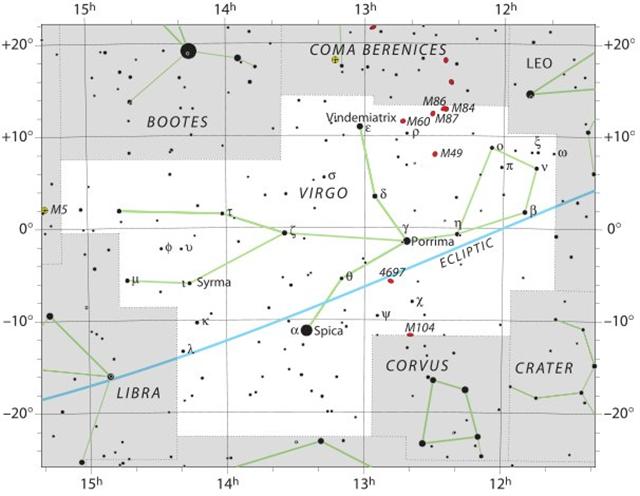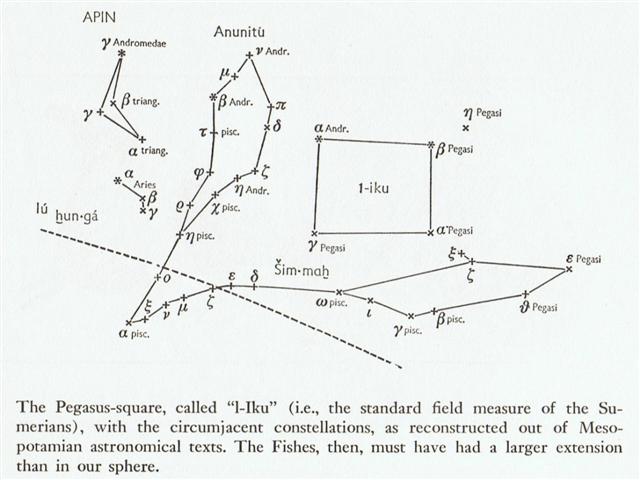In the G text there are 63 glyphs from Rogo
at heliacal Sirrah down in precessional time to the end of side
b on the tablet, to heliacal Hyadum I (*63).
|
3-14
(73) |
MARCH 15 |
16 (440) |
17 |
18 |
19 |
20
(*364) |
 |
 |
 |
 |
 |
 |
 |
|
Gb8-24
(465) |
Gb8-25 |
Gb8-26 |
Gb8-27 |
Gb8-28 |
Gb8-29 |
Gb8-30
(242) |
|
MENKHIB
= ζ Persei
(57.6)
PORRIMA (γ
Virginis)
|
ZAURAK =
γ Eridani
(58.9) |
λ Tauri
(59.3), ν Tauri (59.9) |
4h
(60.9)
JĪSHUĬ =
λ Persei
(60.7)
COR CAROLI
(α Canum Ven.)
|
υ Persei
(61.2) |
BEID =
ο¹ Eridani
(62.2),
μ Persei (62.8)
VINDEMIATRIX ( ε Virginis) |
Al
Dabarān-2
HYADUM I
= γ Tauri
(63.4) |
|
May 17
(137) |
18 (*58) |
19
(*424) |
20 |
21 |
22 |
23
(*428) |
There was a sequence of 63 glyphs also in the C text, viz.
from nakshatra Cor Caroli to heliacal Haedus I:
|
25 |
2-14
(45) |
FEBRUARY 15 |
346 |
JANUARY 28 (393) |
61 |
MARCH 31 (28 + 62) |
 |
 |
 |
 |
|
Ca1-26 |
Ca2-1 (27 = 87 - 60) |
*Ca14-11 (285 + 89) |
Cb2-20 (285 + 151) |
|
kua moe ki te
tai. |
Te heke |
te heke |
ka tuu te toga
o te manu |
|
April 16 (471) |
17 (*27 + 80) |
March 30
(89) |
May
31 (151) |
|
ALRISHA
(*29)
THUBAN (*212) |
HAMAL (*30)
MENKENT (*213) |
*377
(= *12 + 365)
COR CAROLI
(*195) |
HAEDUS I (*74)
*257 |
|
October 16 |
17
(290) |
September 29 (272) |
November 30 (334) |
|
348
(= 12 * 29) |
63
(= 7 * 9) |
Although the distance in days from September 29
up to and including May 31 was (151 - 88) + (*74 + 365 - *257)
= 63 + 182 = 245 days = 35 weeks. And then followed 2 more weeks in order to
reach te taketake:
|
APRIL 1 (91) |
13 |
APRIL 15 (105) |
289 |
 |
 |
|
Cb2-21 |
Cb3-10 (451) |
|
kua tapu - no te manu |
te taketake |
|
June
1 (152 = 91 + 61) |
June
15 (166) |
|
HAEDUS II (*75)
*258 |
PRAJA-PĀTI, MENKALINAN, MAHASHIM
(*89)
*272 |
|
December 1 (260 + 75) |
December 15 (349) |
|
14 |
290
(= 10 * 29) |
35 + 2 = 37 weeks = 259 days, i.e. te
taketake ought to be day 260 (= 20 * 13) from
nakshatra Cor Caroli (Cor Caroli Regis Martyris). 25 + 348 + 259 + 290 = 922 = 740 + 182.
... This
star, the 12th on Flamsteed's list of the Hounds, stands
alone, marking Chara's collar; but was set apart in 1725
by Halley, when Astronomer Royal, as the distinct figure
Cor Caroli, not Cor Caroli II as many have it, in
honour of Charles II.
This was
done at the suggestion of the court physician, Sir
Charles Scarborough, who said it had shone with special
brilliancy on the eve of the king's return to London on
the 29th of May
...
"With Ulug Beg it was
Al Kabd
al Asad,
the Liver of the Lion, - here a technical term
indicating the highest position of any star within the
compass of a figure reckoned from the equator." (Allen)
However, a better way should be to count with
heliacal Hamal at the 1st heke, at the beginning
of the rafters, and with the Liver of the Lion at the
2nd heke, at the end of the rafters. 26 + 348 = 374 = 2 *
187 = 740 - 366:
|
25 |
2-14
(45) |
FEBRUARY 15 |
346 |
JANUARY 28 (393) |
 |
 |
 |
|
Ca1-26 |
Ca2-1 (27 = 87 - 60) |
*Ca14-11 (285 + 89) |
|
kua moe ki te
tai. |
Te heke |
te heke |
|
April 16 (471) |
17 (*27 + 80) |
March 30
(89) |
|
ALRISHA
(*29)
THUBAN (*212) |
HAMAL (*30)
MENKENT (*213) |
*377
(= *12 + 365)
COR CAROLI
(*195) |
|
October 16 |
17
(290) |
September 29 (272) |
|
26 |
348
(= 12 * 29) |
|
61 |
MARCH 31 |
APRIL 1 (91) |
13 |
APRIL 15 (105) |
289 |
 |
 |
 |
|
Cb2-20 (285 + 151) |
Cb2-21 |
Cb3-10 (451) |
|
ka tuu te toga
o te manu |
kua tapu - no te manu |
te taketake |
|
May
31 (151) |
June
1 (152 = 91 + 61) |
June
15 (166) |
|
HAEDUS I (*74)
*257 |
HAEDUS II (*75)
*258 |
PRAJA-PĀTI, MENKALINAN, MAHASHIM
(*89)
*272 |
|
November 30 |
December 1 (260 + 75) |
December 15 (349) |
|
76
(= 4 * 19) |
290
(= 10 * 29) |
|
366 |
Thus the end of side b of the C text
should correspond to the end not only of 290 days
counted from te taketake but also of 366 days
counted from *Ca14-12:
|
*314 |
JANUARY 30 |
31
(396) |
FEBRUARY 1 |
2 |
3 |
 |
 |
 |
 |
 |
 |
|
*Ca14-12 |
*Ca14-13 |
*Ca14-14 |
*Ca14-15 (378) |
*Ca14-16 |
*Ca14-17 |
|
te kihikihi |
o te henua - kua haga hia |
kua pua |
te vero |
te henua |
kiore - te henua |
|
March 31 |
April 1 (91) |
2 |
3
(*378) |
4 |
5
(460) |
|
*378
(= *13 + 365)
VINDEMIATRIX
(*196) |
*14
*197 |
*380
DIADEM (*198) |
ANUNITUM
(τ)
REGULUS
*199 |
*382
*200 |
*383
(= *18 + 365)
*201 |
|
FEBRUARY 4 |
5
(36) |
6 |
7
(403) |
8 |
9
(*325) |
 |
 |
 |
 |
 |
 |
|
*Ca14-18 |
*Ca14-19 |
*Ca14-20 |
*Ca14-21 (384) |
*Ca14-22 |
*Ca14-23 |
|
te honu paka |
te henua |
honu kau |
te mata |
te honu |
kua heheu |
|
April 6 |
7 |
8
(*383) |
9
(464) |
10 |
11 |
|
ADHIL (*384)
SPICA
SADALMELIK
(*202) |
*385
*203 |
*386
*204 |
*387
HEZE (*205) |
ACHERNAR (*23)
*206 |
*24
*207 |
|
FEBRUARY 10 |
11 |
12
(408) |
13 (*329) |
2-14 |
15 (46) |
 |
 |
 |
 |
 |
 |
|
*Ca14-24 |
*Ca14-25 |
*Ca14-26 |
*Ca14-27 |
*Ca14-28 |
*Ca14-29 (392) |
|
te henua |
te honu kau |
manu kake rua |
te henua |
te honu |
te rima |
|
April 12 |
13 |
14
(104) |
15 |
16
(471) |
17
(*392) |
|
*390
BENETNASH (*208) |
POLARIS (*26)
*209 |
SHERATAN (*27 = *392 - 365)
MUPHRID (*210) |
*393
*211 |
ALRISHA (*29)
THUBAN (*212) |
HAMAL
ALKES
(*30)
MENKENT (*213) |
The synodic cycle of Saturn was 378 days
and 378 days after 0h was *378, which in turn
was 64 days more than *314 .
Once upon a time, it could have been
calculated, the night after that when Cor Caroli had
been close to the Full Moon - at the 2nd heke,
marking the end of the rafters, at the Liver of the Lion
- had been JANUARY 29 (*314).
At the time of
rongorongo, 64 precessional days later, this would have happened
in April 3 (*378 = 365 + *13) when Vindemiatrix - like
the fist on the raised up right arm of Virgo - was at
the Full Moon.

But according to the C calendar *378 was
in April 3 when the Sun rose with Anunitum and
when Regulus culminated at midnight. Here we can guess
why the creator of the
text had placed a vero.

There were 3 nights from Vindemiatrix up
to the rising fish Anunitum (τ).
| Kihi
Kihikihi, lichen; also:
grey, greenish grey, ashen. Vanaga.
Kihikihi, lichen T,
stone T. Churchill.
The Hawaiian day was divided in three general
parts, like that of the early Greeks and Latins,
- morning, noon, and afternoon - Kakahi-aka,
breaking the shadows, scil. of night;
Awakea, for Ao-akea, the plain full
day; and Auina-la, the decline of the day.
The
lapse of the night, however, was noted by five
stations, if I may say so, and four intervals of
time, viz.: (1.) Kihi, at 6 PM, or about
sunset; (2.) Pili, between sunset and
midnight; (3) Kau, indicating midnight;
(4.) Pilipuka, between midnight and
surise, or about 3 AM; (5.) Kihipuka,
corresponding to sunrise, or about 6 AM ...
(Fornander) |
|
Egyptian sticks |
 |
Phoenician
taw |
 |
Greek chi |
Χ (χ) |
|
Greek tau |
Τ (τ) |
|
In Plato's
Timaeus, it is explained that the two
bands that form the soul of the world cross
each other like the letter Χ.

Chi or X is
often used to abbreviate the name Christ, as
in the holiday Christmas (Xmas). When fused
within a single typespace with the Greek
letter Rho, it is called the labarum and
used to represent the person of Jesus
Christ. (Wikipedia)

... tau
is the 19th letter of the Greek alphabet. In
the system of Greek numerals it has a value
of 300 ... Taw is believed to be
derived from the Egyptian hieroglyph meaning
'mark' ...
Taw,
Tav or Taf is the
twenty-second and last letter in many
Semitic abjads ... In gematria Tav
represents the number 400, the largest
single number that can be represented
without using the Sophit forms ...
'From
Aleph to Taf' describes something
from beginning to end; the Hebrew equivalent
of the English 'From A to Z' ...
Tav is
the last letter of the Hebrew word emet,
which means truth. The midrash explains that
emet is made up of the first, middle,
and last letters of the Hebrew alphabet (Aleph,
Mem, and Tav...).
Sheqer (falsehood), on the other
hand, is made up of the 19th, 20th, and 21st
(and penultimate) letters.
Thus, truth
is all-encompassing, while falsehood is
narrow and deceiving. In Jewish mythology it
was the word emet that was carved
into the head of the Golem which
ultimately gave it life. But when the letter
'aleph' was erased from the Golem's
forehead, what was left was 'met' -
dead. And so the Golem died ...
(Wikipedia)

|
|


















